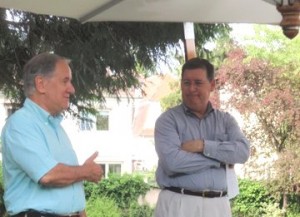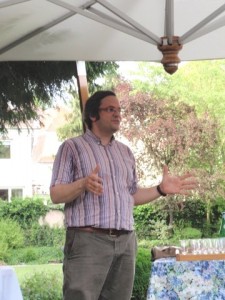Fourth of July in Strasbourg, with California wines
July 5, 2012
Jack Hanning, whom I will thank always for having initially hired me to work in media relations at the Council of Europe – way back in 1996 – looked me up for a club of English speakers (and wine lovers) in Strasbourg, and asked me to organise a wine tasting at the US consulate on the occasion of 4 July, Independence Day.
Declaring independence from the British Monarch, the 13 colonies created an enduring democracy, interrupted only by a terrible Civil war in the mid-19th century.
The U.S. is part of the “New World” but its roots lie in Europe , and the great men who signed the Declaration of Independence drew their inspiration from liberal minded European philosophers, from Voltaire to John Locke.
And a similar thing can be said for many great American wines, many of which use grapes from the Old World, from Cabernet Sauvignon and Chardonnay to Sauvignon Blanc and Riesling.
Many thanks to U.S. Consul Evan G. Reade and his wife Mary Rose for hosting at their gorgeous residence, where participants enjoyed sunny weather in an expansive garden: a fine environment to taste some lovely American wines.
Thanks also to Terry Hall of Napa Valley Vintners, whom I have known now for several years. He kindly organised a shipment of five different wines – most all in a mid-price range category – to be tasted on this special occasion.
Because I am hardly the California wine specialist, having visited Napa and Sonoma only twice in my life so far, it was a learning experience for me, too, as I had not tried any of the wines before, with the exception of the Silverado Cabernet, but in another vintage.
In any case, several people came up to me afterwards to say that they were pleasantly surprised by the quality, and two were already planning a trip to the Napa Valley and wanted a list of places to visit. I recommended Dominus, Heitz, Duckhorn and some others – places I had already visited. But also some of the nice wines we tried at the tasting.
Here some brief notes, from memory. When in bold, I liked particularly. Red and bold, even more. When underlined, the most!
Whites
Grgich Hills Estate Fume Blanc 2010: Spring temperatures in 2010 were below average, with above average rain (after several drought vintages) and cool temperatures into the summer allowed for steady but slow grape ripening until a series of heat spikes brought needed warmth to ripen the grapes. This Sauvignon Blanc impressed many tasters for its broad mouth feel and good acidity, as well. The 14.3% alcohol was decently integrated, and the wine exuded some Kiwi and exotic fruit as well as crisp citrus aspects. The oak is not new here, so there is not too much of an oaky flavour, and that is a plus. I enjoyed this wine. Average retail: €20 and a good price/quality ratio.
Trefethen Harmonay Chardonnay 2008: Could this have been the wine of the entire tasting? The wine exuded lovely floral aromatics, the attack was smooth yet brisk, and the palate creamy, with notes of white peach and lemon meringue. The judicious use of just 20% new oak did this wine a service. Most tasters liked this more than the preceding wine, including a Burgundy lover who was fully impressed, especially after I explained the story of the Judgment of 1976, where several California wines – judged by French wine critics in a blind tasting – beat the best French wines at the time. In 1979, a Wine Olympics was organized by the French wine and food magazine, GaultMilllau. A total of 330 wines from 33 countries were evaluated by 62 experts from ten countries. The 1976 Trefethen Vineyards Chardonnay won first place in that category and was judged best in the world. This wine lived up to its reputation. Average retail: €40.
Reds
I had opened all three beforehand to taste, and found the Silverado to be a bit tight, the Spring Mountain more exuberant and spicy, but perhaps slightly oak derived, and the Cuvaison to be the most fruit forward. So the wines were served in that order, although I had no idea coming into the tasting what each wine costs. We popped and poured, but guests were able to revisit open bottles later. I found that the Silverado got a bit better in glass, the Cuvaison stayed fun but perhaps lacked a long finish, and the Spring Mountain had the most exotic of noses and flavours.
Silverado Vineyard Cabernet Sauvignon 2008: Released in February this year, this wine is made from grapes grown in the Stags Leap, Mt. George Vineyard and a bit from Oakville . A drought season, with spring being one of the driest on record. Irrigation was needed. Summer was cooler, however, but harvest was still precocious due to early vine development in the spring. As said, I found the wine a bit closed, even somewhat disjointed, but with potential. There was some black cherry fruit that was appealing, but tannic power, too. Give it a couple of years. Aged in 42% new oak. Average retail: €30
Spring Mountain Vineyard Estate bottled Cabernet 2008. Here we have a wine with more grip and definition, most agreed. Aged in 100% new oak; we also have oak-derived spice(s), but not overbearing. Indeed, I quite liked the clove and cinnamon aspects and Mary Rose and I talked about food for this: rosemary lamb would go well! A very pleasurable wine and one with perhaps the most substance of all three reds. Average retail: €55
Cuvaison Estate Cabernet Mt Veeder 2009. As said, this seemed to be the most forward of the wines – and perhaps the most pleasurable to drink today. For most of the 2009 harvest in Napa Valley , things went smoothly. Napa’s biggest “money grape” is Cabernet Sauvignon, which enjoyed ideal growing conditions until October, when a pair of strong storms dumped enough rain to worry growers. Those who picked before the storms were excited about colour, flavour, acids and tannins. But those who waited out the deluge faced a mixed bag. Cuvaison harvested from 7 to 29 October, but I am not sure how the storms affected the quality – this was the first time I tried this wine. Although one or two participants thought the finish was short, most enjoyed this wine the most for current drinking. It displayed somewhat heady aromas and flavours of plum and cherry fruits, with a rounded, pleasing mouth feel. Now, what I did not realize is that this was the least expensive of all the reds… So in terms of price quality ratios, this proved to be a good deal. Average retail: €25
It was a lot of fun tasting California wines, which are very difficult to find in Strasbourg. Writing this one day afterwards, I really think that the Chardonnay was the most special of the wines we tried.






[…] http://www.connectionstowine.com (via @SpringMtnVyd) – Today, 10:12 PM […]
I have tasted these vintages side-by-side several times and the last time was about seven months ago. Tonight, the ’07 was magical and the ’08 was a little closed down. Chris’ masterful winemaking technique has produced wines that will truly shine with time in the cellar. I have found over and over that only the very best wines get better with time and the ones that do, provide ethereal experiences. Chris has created this caliber of wine for Doubleback. The ’07 nose explodes out of the glass with clean, pretty floral notes. The ‘07 is soft but very complex on the palate. The finish dies out after about 45 seconds but leaves you wanting the next sip.